Incidence and Treatment Trends of Achilles Tendon Ruptures in Finland: A Nationwide Study
Leino Oskari; Keskinen Heli; Löyttyniemi Eliisa; Mäkelä Keijo; Ekman Elisa; Laaksonen Inari
https://urn.fi/URN:NBN:fi-fe202301051539
Tiivistelmä
Background: Global reports indicate rising Achilles tendon rupture (ATR) incidence. In recent decades, the optimal treatment for this injury has been widely studied. Alongside the cumulating comparative evidence regarding the optimal method of treatment, nonoperative treatment has increased in popularity compared with operative treatment.
Purpose: To determine the current incidence of ATRs and their treatment in Finland and how these have changed from 1997 to 2019.
Study design: Descriptive epidemiology study.
Methods: Two national registers (the National Hospital Discharge Register and the Finnish Register of Primary Health Care Visits) were used to identify all ATR cases and operations to treat them; the incidence was calculated based on the annual adult population size.
Results: During the study period, ATR incidence increased from 17.3 to 32.3 per 100,000 person-years. The increase in incidence seemed to plateau starting in the second half of the study period. The rise in ATR incidence occurred in both sexes and all age groups but most markedly among the elderly. The incidence of operative treatment decreased from 13.6 to 4.9 per 100,000 person-years. This decline was observed from 2008 onward and in all age groups.
Conclusion: The incidence of ATRs increased and the use of operative treatment decreased. The decreasing trend of operative treatment is in line with other international reports and resonates with the current literature about the optimal treatment of ATRs.
Kokoelmat
- Rinnakkaistallenteet [27094]
